In late December of last year, I labeled Dorohedoro one of my most anticipated series of winter 2020. Honestly, that was a poser move. I’m not a manga reader, so my high expectations were based largely on secondhand praise, plus the potential for bloody irreverence promised by the PV and synopsis. There was one element of the show’s production, though, that I was confident would give it a unique appeal: the involvement of Shinji Kimura, background artist for such films as My Neighbor Totoro and Akira. He’s done plenty of great work as an art director, too, which was his role on this project. Sure enough, Dorohedoro’s grimy cityscapes and ramshackle interiors were uncommonly polished for a TV production – but the show had much more going for it than detailed backgrounds. A potpourri of violence, mystery, and a strangely loveable cast, Dorohedoro proved itself as one of this season’s strongest offerings, despite its task of adapting an unadaptable story.
If this show’s various elements comprise a recipe, then the characters are the secret ingredient. Half of them are murderers, and a quarter are very likely psychopathic, but beneath their magic-enhancing masks and blood-soaked tracksuits lie remarkably human hearts. The show’s habit of creating character pairs is a winning strategy, giving them similarly-minded people with whom they can exchange fun dialogue, even in the midst of tense situations. I can still picture Shin (a “cleaner” in a mafia organization) lecturing his protegee Noi about her choice of weaponized silverware at a dinner party turned assassination. That scene comes from an early episode, but it’s as clear to me as anything from more recent installments, because it so effectively melded their status as killers with their senpai/kouhai banter. Mealtime conversations are plentiful in Dorohedoro, functioning as opportunities for backstory delivery and subtle worldbuilding (in the form of dropped names and locations).
In fact, food plays a significant role in most episodes, whether it’s Caiman helping Nikaido buy a new meat grinder or En judging a pie contest between rival food trucks. The practices of food preparation and consumption serve as unifiers in a world where gang warfare and human experimentation are commonplace. What’s remarkable is that these tones don’t clash in the least, since Dorohedoro is dedicated to the depiction of the mundane. Even when a group of characters search for the decapitated head of a former syndicate member, their idle chatter on the way to their destination receives plenty of emphasis. That’s not to say that the show is without structure, however – Caiman’s quest to discover his true identity remains in focus for all twelve episodes, guiding the story in a way that’s easy to follow. I won’t claim to understand how the puzzle pieces fit together, since Dorohedoro belongs to the mystery genre as much as it does any other, but it’s never hard to watch.
Though its style makes for easy viewing, the series occasionally moves too briskly for its own good. In my review of episode 5, I labeled this practice “unloading all its groceries at once,” and since we’ve just discussed food’s importance to the story, that comparison seems apt. Some chapters are loaded with flashbacks, dreams, or both, and though their intentional vagueness preserves the show’s mystery, their flow can be distractingly choppy. In addition, moments where multiple characters converge at one location struggle to transmit a point of view, since their entrances and exits are often omitted to save time. The other major critique I have lies with the show’s visuals – not the backgrounds, but the 3DCG character models used for the principal cast. These models have actually received quite a bit of praise from fans, but I found that they clashed with the far richer environments on display. Sure, they look nicer than the PS2 cutscene-tier models of yesteryear, but they’re nowhere close to “great.” Thankfully, the characters are so lifelike in their own right that any stiffness in their movement doesn’t subtract from the story.
Perhaps the best word to describe Dorohedoro is “singular.” The show plays like nothing else, a raucous fusion of gory action, dimension hopping, buddy film tropes, and musings on identity. Neither its story nor its animation are perfectly delivered, but the show is so audacious and inventive that dwelling on its flaws for too long is impossible. There’s always a new character costume, a new piece of hellish background art, or a new hint about Caiman’s former self around the corner. The last of those intriguing sources provides a hell of a throughline for this season, as well as a hook for a potential follow-up (which I’ll surely be watching). With the main characters on the run from a deadly mushroom-spewing sorcerer, detailing their escape will be the sequel’s first order of business. Assuming they can give him the slip, though, what then? What craziness will the series dive into next? That is still a mystery. That is… Dorohedoro.


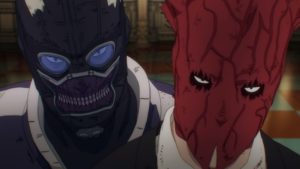
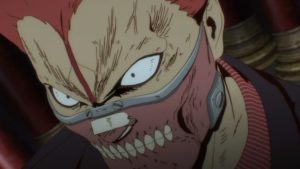
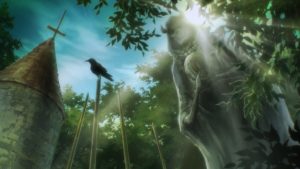
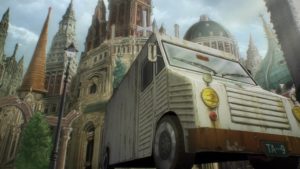
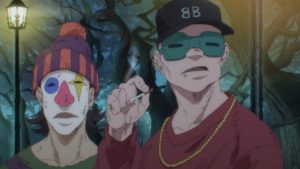
Were the characters the only element that was CG? I honestly have this weird thing where I barely notice CG and it doesn’t bother me either. However, I know the part of the show where we get Shin’s background was CG-free and it looked amazing . And what the point of CG anyway? Is it just cheaper?
I hate the use of CGI. I got used to it but why the fuck the didn’t the creators just stick with 2D animation? The pacing was also too quick and cut out a few chapters and scenes from the manga. Why? Manga is fucking complete so no need to rush through everything. Would it had fucking killed them to go with 24 episodes or something.
Despite my complaints instill liked the anime. Cast is likeable,mystery is good and voice acting is strong. I hope we get S2 next year.